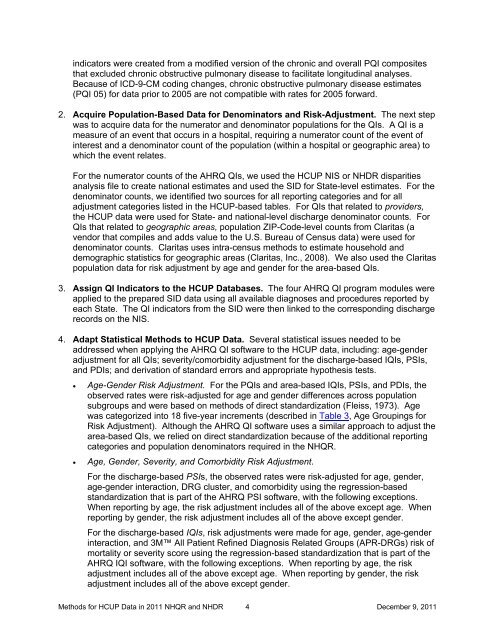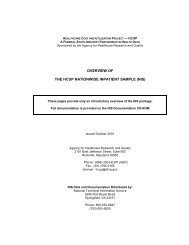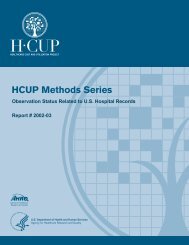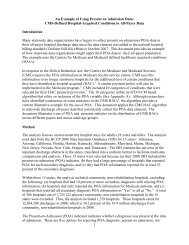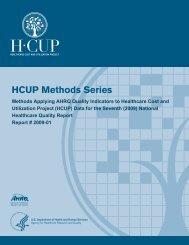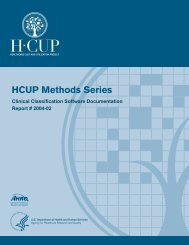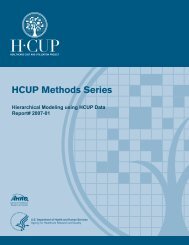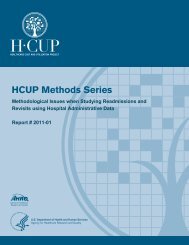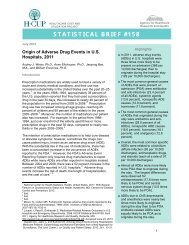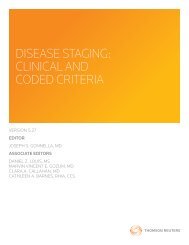Methods Applying AHRQ Quality Indicators to Healthcare ... - HCUP
Methods Applying AHRQ Quality Indicators to Healthcare ... - HCUP
Methods Applying AHRQ Quality Indicators to Healthcare ... - HCUP
Create successful ePaper yourself
Turn your PDF publications into a flip-book with our unique Google optimized e-Paper software.
indica<strong>to</strong>rs were created from a modified version of the chronic and overall PQI compositesthat excluded chronic obstructive pulmonary disease <strong>to</strong> facilitate longitudinal analyses.Because of ICD-9-CM coding changes, chronic obstructive pulmonary disease estimates(PQI 05) for data prior <strong>to</strong> 2005 are not compatible with rates for 2005 forward.2. Acquire Population-Based Data for Denomina<strong>to</strong>rs and Risk-Adjustment. The next stepwas <strong>to</strong> acquire data for the numera<strong>to</strong>r and denomina<strong>to</strong>r populations for the QIs. A QI is ameasure of an event that occurs in a hospital, requiring a numera<strong>to</strong>r count of the event ofinterest and a denomina<strong>to</strong>r count of the population (within a hospital or geographic area) <strong>to</strong>which the event relates.For the numera<strong>to</strong>r counts of the <strong>AHRQ</strong> QIs, we used the <strong>HCUP</strong> NIS or NHDR disparitiesanalysis file <strong>to</strong> create national estimates and used the SID for State-level estimates. For thedenomina<strong>to</strong>r counts, we identified two sources for all reporting categories and for alladjustment categories listed in the <strong>HCUP</strong>-based tables. For QIs that related <strong>to</strong> providers,the <strong>HCUP</strong> data were used for State- and national-level discharge denomina<strong>to</strong>r counts. ForQIs that related <strong>to</strong> geographic areas, population ZIP-Code-level counts from Claritas (avendor that compiles and adds value <strong>to</strong> the U.S. Bureau of Census data) were used fordenomina<strong>to</strong>r counts. Claritas uses intra-census methods <strong>to</strong> estimate household anddemographic statistics for geographic areas (Claritas, Inc., 2008). We also used the Claritaspopulation data for risk adjustment by age and gender for the area-based QIs.3. Assign QI <strong>Indica<strong>to</strong>rs</strong> <strong>to</strong> the <strong>HCUP</strong> Databases. The four <strong>AHRQ</strong> QI program modules wereapplied <strong>to</strong> the prepared SID data using all available diagnoses and procedures reported byeach State. The QI indica<strong>to</strong>rs from the SID were then linked <strong>to</strong> the corresponding dischargerecords on the NIS.4. Adapt Statistical <strong>Methods</strong> <strong>to</strong> <strong>HCUP</strong> Data. Several statistical issues needed <strong>to</strong> beaddressed when applying the <strong>AHRQ</strong> QI software <strong>to</strong> the <strong>HCUP</strong> data, including: age-genderadjustment for all QIs; severity/comorbidity adjustment for the discharge-based IQIs, PSIs,and PDIs; and derivation of standard errors and appropriate hypothesis tests.Age-Gender Risk Adjustment. For the PQIs and area-based IQIs, PSIs, and PDIs, theobserved rates were risk-adjusted for age and gender differences across populationsubgroups and were based on methods of direct standardization (Fleiss, 1973). Agewas categorized in<strong>to</strong> 18 five-year increments (described in Table 3, Age Groupings forRisk Adjustment). Although the <strong>AHRQ</strong> QI software uses a similar approach <strong>to</strong> adjust thearea-based QIs, we relied on direct standardization because of the additional reportingcategories and population denomina<strong>to</strong>rs required in the NHQR.Age, Gender, Severity, and Comorbidity Risk Adjustment.For the discharge-based PSIs, the observed rates were risk-adjusted for age, gender,age-gender interaction, DRG cluster, and comorbidity using the regression-basedstandardization that is part of the <strong>AHRQ</strong> PSI software, with the following exceptions.When reporting by age, the risk adjustment includes all of the above except age. Whenreporting by gender, the risk adjustment includes all of the above except gender.For the discharge-based IQIs, risk adjustments were made for age, gender, age-genderinteraction, and 3M All Patient Refined Diagnosis Related Groups (APR-DRGs) risk ofmortality or severity score using the regression-based standardization that is part of the<strong>AHRQ</strong> IQI software, with the following exceptions. When reporting by age, the riskadjustment includes all of the above except age. When reporting by gender, the riskadjustment includes all of the above except gender.<strong>Methods</strong> for <strong>HCUP</strong> Data in 2011 NHQR and NHDR 4December 9, 2011


